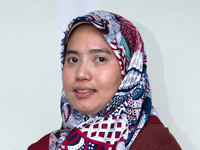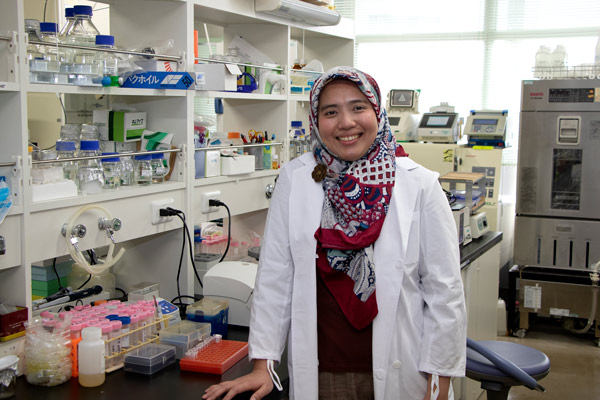Apr. 1, 2021
Human-spun spider silk
Nur Alia Oktaviani, Special Postdoctoral Researcher

Biomacromolecules Research Team, RIKEN Center for Sustainable Resource Science
Describe your role at RIKEN.
I’m a special postdoctoral researcher in the Biomacromolecules Research team at the RIKEN Center for Sustainable Resource Science, where I study the self-assembly mechanisms of spider-silk proteins.
How did you become interested in your current field of research?
I’ve always been interested in investigating the molecular mechanisms underlying protein function. Spider silk is a protein-based material known for its extraordinary strength and elasticity, and it should have many industrial applications.
However, as spiders can’t be farmed (due to their cannibalistic tendencies) researchers require artificial spider silk to be able to investigate its uses. To create this, we are trying to create a spinning system that mimics the materials and conditions of the spider silk gland. However, we don’t fully understand the processes that transform the highly soluble silk proteins within the spider gland into an insoluble, strong and elastic biomaterial. So my research focuses on understanding the self-assembly mechanism of spider silk proteins.
What excites you the most about your current research?
I’m investigating spider silk self-assembly mechanisms at the molecular level. Alongside other biophysical techniques, I’m using the multidimensional nuclear magnetic resonance (NMR) spectroscopy facility at RIKEN’s Yokohama campus. The most exciting part of my research is when I get good-intensity, high-resolution spectra data on spider-silk proteins. This allows me to do NMR chemical shift assignments, so I can analyze and interpret structural spider silk protein data at the molecular level.

What has been the most interesting discovery in your field in the last few years?
For many years, researchers used organic solvents to spin artificial spider-silk fibers. However, they were not as strong or tough as natural silk. A few years ago, researchers tried to mimic the environment in the spider gland and greatly improved the mechanical properties of artificial spider silk, even though it is still not quite as good as native spider silk. This discovery prompted me to look for better understandings of the mechanisms underlying natural spinning processes.
How and when did you join RIKEN?
I joined RIKEN in February 2015 as a postdoctoral researcher. My family and I moved to Japan because my husband had been given a position at RIKEN. Soon after I arrived, I found a vacant role as postdoctoral researcher in the Biomacromolecules Research Team and applied for the job.
How do you balance family life with your work at RIKEN?
My husband and I are both researchers at RIKEN and we have two children. Balancing family life sometimes isn’t easy, but RIKEN is incredibly flexible and supportive of researchers with families, which helps a lot.
